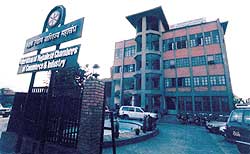 Through my work at Business Service Aadhar, I meet many young Nepali entrepreneurs and businesspeople in their late 20s and 30s. I ask them whether they or their firms are members or beneficiaries of the Federation of Nepalese Chambers of Commerce and Industry (FNCCI). Almost all of them-educated, aware and market-savvy-say no. Some blame labyrinthine dealings with the FNCCI bureaucracy.
Through my work at Business Service Aadhar, I meet many young Nepali entrepreneurs and businesspeople in their late 20s and 30s. I ask them whether they or their firms are members or beneficiaries of the Federation of Nepalese Chambers of Commerce and Industry (FNCCI). Almost all of them-educated, aware and market-savvy-say no. Some blame labyrinthine dealings with the FNCCI bureaucracy. Their uniform reluctance to join FNCCI struck me as curiously odd. With slightly more than 80 percent of Nepal's 2.5 million population under the age of 40, and with more young Nepalis running, starting and managing their own businesses, why is the FNCCI, the so-called premier body for business and commerce, viewed not as a resource to be tapped into, but as a far-removed, irrelevant entity by most young people? Is FNCCI, as some speculate, doomed to being a nest for quarrelsome traders who, having made their fortunes dealing in cars, arms and garments, want to use it as a stepping stone into national politics?
Image makeover: FNCCI is sorely in need of an image makeover. With a few exceptions, its leaders and members are viewed as those who have made their wealth through inheritance and government-issued monopolistic licenses dating from the Panchayat days and not by taking risks, engaging in the rough-and-tumble of the marketplace to come up with innovative products and services.
If FNCCI wants to change this image, it needs to start wooing young businesspeople by serving as a platform for them to obtain usable information, make use of available knowledge and tap into networks-fast. To that end, it has to adapt its bureaucracy to be more agile, responsive and service-oriented. FNCCI, the comfortable clubhouse for traders must become FNCCI, the forward-looking knowledge organisation for all, especially Nepali businesses with young leaders.
Market-led: At times, FNCCI, the supposed vanguard of the market, comes across as just another donor-subsidised market-distorting organisation. A case in point is its training programs, which are offered to private sector businesses at prices that range from Rs 300 to Rs 1500 per participant. Though well-intentioned, there are unintended consequences: first, the low prices discourage private sector training providers from going out and charging full fees for their programs. Second, they do not make recipients of trainings appreciate and pay for the full cost of such programs. And third, they distort the behaviour of both the providers and the recipients to dance to the tune of easy donor money. As a result, as soon as donor funds dry up, such programs are no longer offered.
Sure, FNCCI may want to use donor funds as a catalyst to strengthen its institutional mechanism. But it should stay away from using those funds to subsidise programs for which there already exists a vibrant private sector market. Such an approach is important for the institutional integrity of FNCCI.
Finally, the newly elected FNCCI leaders must ask themselves how their organisation is to remain relevant to Nepali businesses. And it must define how it differs from other organisations that also aim to act as some sort of a chamber for businesses. Aggressively transforming FNCCI into a prompt knowledge-sharing organization would address the first concern, while championing markets and competition-and not pleading the government for special patriotism-tinged protections-would address the second.
Only then, FNCCI can start marketing itself to the next generation of Nepal's business comminity.



